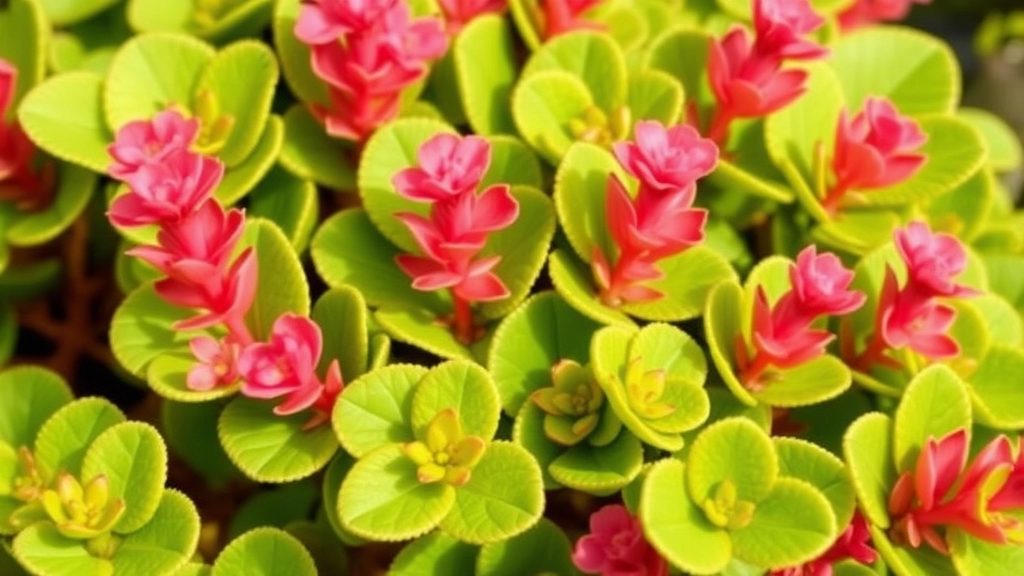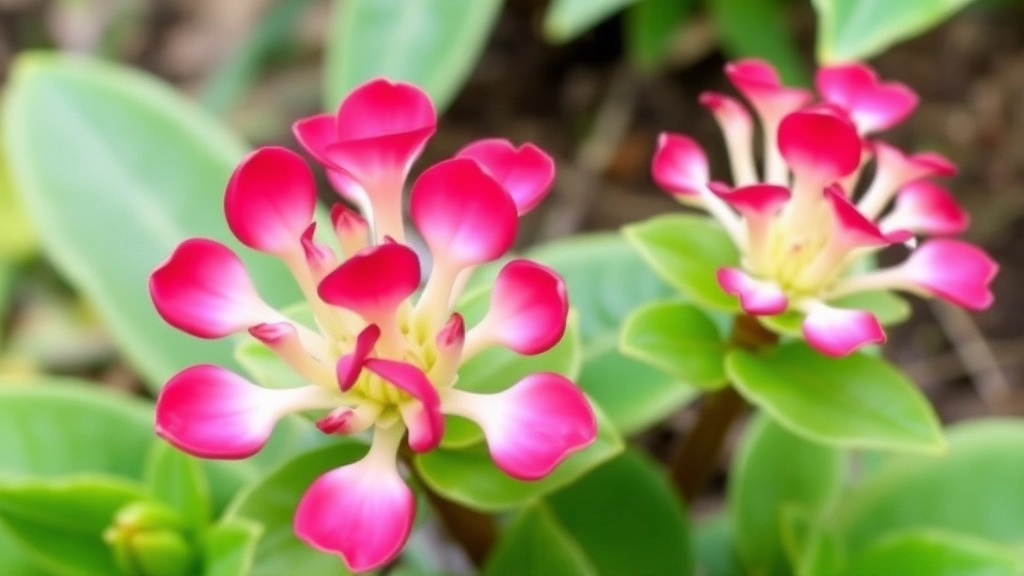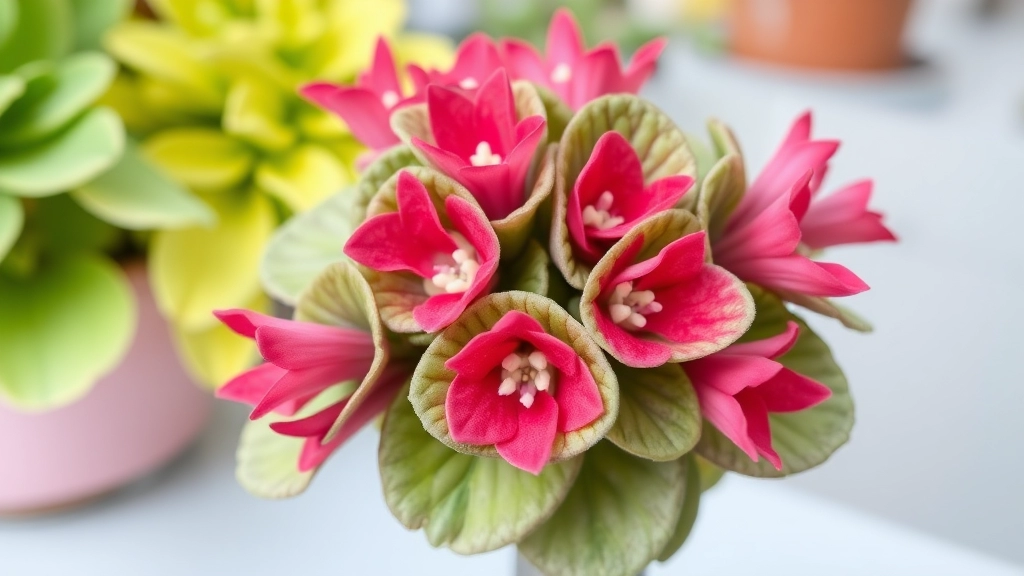Kalanchoe Gastonis Bonnieri: A Natural Remedy
When it comes to exploring natural remedies, the Kalanchoe Gastonis Bonnieri plant, also known as the Donkey Ear plant, has piqued interest for its potential anticancer properties. Traditionally used in folk medicine for treating inflammation and tumors, this plant is now under scientific scrutiny for its bioactive compounds. These compounds, including flavonoids, show promise in exhibiting antioxidant, anti-inflammatory, and possibly anticancer effects.
Therapeutic Applications
Studies on Kalanchoe Gastonis Bonnieri suggest that its therapeutic applications could extend to cancer treatment. While research is still ongoing, early findings indicate that this plant’s secondary metabolites might offer a natural complement to conventional cancer therapies. However, it’s crucial to approach these findings with cautious optimism and await further studies to fully understand its efficacy and safety in humans.
Medicinal Uses of Kalanchoe Gastonis-Bonnieri
Are you seeking natural remedies that could complement traditional cancer treatments?
Kalanchoe Gastonis-Bonnieri, often overlooked, has garnered attention for its potential medicinal properties, particularly in the realm of cancer treatment.
Traditional Uses
Historically, various cultures have utilised Kalanchoe Gastonis-Bonnieri for its therapeutic benefits.
- Anti-inflammatory properties: Traditionally, it has been used to alleviate inflammation, which can be a significant concern for cancer patients.
- Wound healing: The plant is also known for its ability to speed up the healing process of wounds, making it valuable for those undergoing surgery or other invasive treatments.
- Pain relief: Some communities have employed Kalanchoe Gastonis-Bonnieri as a natural pain reliever, providing comfort during challenging times.
Modern Applications
In recent years, the focus has shifted towards understanding how this plant can be integrated into modern medicine.
- Nutraceuticals: Many health enthusiasts are turning to Kalanchoe Gastonis-Bonnieri as a dietary supplement, believing it can boost overall health and potentially support cancer treatment.
- Alternative therapies: Some practitioners are exploring its use alongside chemotherapy and radiation, aiming to enhance the efficacy of these conventional treatments.
Active Compounds in Kalanchoe Gastonis-Bonnieri for Cancer Treatment

So, you’re curious about what makes Kalanchoe Gastonis-Bonnieri tick in the world of cancer treatment? You’re not alone. Many people are looking for natural alternatives that pack a punch against this formidable disease.
This remarkable plant is known for its rich array of active compounds, which have caught the attention of researchers and health enthusiasts alike.
Key Compounds to Note
- Flavonoids
These are powerful antioxidants that help combat oxidative stress in the body. They may also have anti-inflammatory properties, which could be beneficial in cancer treatment. - Alkaloids
Some alkaloids found in Kalanchoe Gastonis-Bonnieri have shown potential in inhibiting cancer cell growth. They work by disrupting the processes that allow cancer cells to thrive. - Saponins
These compounds have been studied for their ability to induce apoptosis, or programmed cell death, in cancer cells. This is crucial because it helps eliminate cells that could otherwise multiply unchecked. - Triterpenes
Known for their anti-inflammatory and anticancer properties, triterpenes can help in reducing the size of tumors and slowing down cancer progression.
Why These Compounds Matter
Understanding these compounds is essential because they highlight the potential of Kalanchoe Gastonis-Bonnieri as a complementary treatment in cancer therapies.
Imagine being able to harness the natural power of these compounds to support your body while undergoing traditional treatments. It’s like having a secret weapon in your corner.
Real-Life Impact
People are turning to Kalanchoe Gastonis-Bonnieri not just for its beauty but for its potential health benefits. Many have shared stories of improved well-being and resilience during their cancer journeys after incorporating this plant into their routines.
Traditional and Modern Applications in Cancer Therapies
When considering the diverse approaches to cancer treatment, Kalanchoe Gastonis-Bonnieri emerges as a noteworthy player. This plant has a rich history in traditional medicine, particularly in various cultures where it has been used for its purported healing properties.
Scientific Studies on Kalanchoe Gastonis-Bonnieri and Cancer

As we delve into the scientific landscape surrounding Kalanchoe Gastonis-Bonnieri, it’s crucial to understand how research has illuminated its potential in cancer treatment.
Key Research Findings
Recent studies have highlighted several promising aspects of Kalanchoe Gastonis-Bonnieri in combating cancer:
- Antitumor Activity: Research has indicated that extracts from Kalanchoe Gastonis-Bonnieri exhibit significant antitumor properties. These extracts have been shown to inhibit the growth of various cancer cell lines, including breast and lung cancer.
- Mechanisms of Action: Studies suggest that the active compounds in Kalanchoe Gastonis-Bonnieri may induce apoptosis (programmed cell death) in cancer cells. This is a crucial mechanism, as it helps eliminate dysfunctional cells that contribute to tumor growth.
- Synergistic Effects: There is evidence that Kalanchoe Gastonis-Bonnieri can enhance the efficacy of conventional chemotherapy drugs. This synergy could lead to reduced dosages of these drugs, potentially lowering side effects for patients.
Notable Research Examples
- In Vitro Studies: Several in vitro studies have demonstrated that Kalanchoe Gastonis-Bonnieri extracts can significantly reduce cell viability in various cancer types.
- Animal Trials: Animal models have shown promising results, where administration of Kalanchoe Gastonis-Bonnieri extracts led to reduced tumor sizes and improved survival rates.
- Clinical Trials: Although still in the early stages, some clinical trials are exploring the efficacy of Kalanchoe Gastonis-Bonnieri as a complementary treatment alongside standard therapies.
Implications for Cancer Treatment
The findings from these studies underscore the potential of Kalanchoe Gastonis-Bonnieri as a valuable addition to cancer treatment regimens.
- Complementary Therapy: It may serve as a supportive agent, enhancing the overall effectiveness of existing treatments.
- Natural Alternative: For patients seeking natural options, Kalanchoe Gastonis-Bonnieri presents an intriguing possibility.
Potential Side Effects and Safety Considerations
As we delve deeper into the medicinal properties of Kalanchoe Gastonis-Bonnieri, it is crucial to address the potential side effects and safety considerations associated with its use, particularly in cancer treatment.
Common Side Effects
While Kalanchoe Gastonis-Bonnieri is celebrated for its therapeutic properties, it is not without risks. Some individuals may experience:
- Gastrointestinal Disturbances: Nausea, vomiting, or diarrhoea can occur, especially with higher doses.
- Allergic Reactions: Skin rashes or itching may arise in sensitive individuals.
- Hypotension: Some users have reported lower blood pressure, which can lead to dizziness or fainting.
Safety Considerations
When considering Kalanchoe Gastonis-Bonnieri as part of a cancer treatment regimen, it is essential to keep the following safety tips in mind:
- Consult Healthcare Professionals: Always discuss with a doctor before starting any new herbal treatment, especially if undergoing conventional cancer therapies.
- Monitor for Interactions: Kalanchoe may interact with other medications, particularly those affecting blood pressure or blood sugar levels.
- Pregnancy and Breastfeeding: Its safety during pregnancy and lactation has not been established, so caution is advised.
Individual Variability
Not everyone will experience side effects, and reactions can vary widely based on individual health conditions and concurrent treatments.
As we dive deeper into the world of Kalanchoe Gastonis-Bonnieri, one question keeps popping up: what’s next for this intriguing plant in cancer treatment?
### Expanding Research Horizons
There’s a buzz in the air about the potential of Kalanchoe Gastonis-Bonnieri. Researchers are keen to explore its capabilities further, and here’s why:
– **Mechanisms of Action**: We need to understand how its active compounds work at a cellular level. What pathways do they target?
– **Combination Therapies**: Could Kalanchoe work well with existing cancer treatments? Exploring this could lead to more effective therapies.
– **Dosage and Delivery**: What’s the ideal dosage? How can we deliver it effectively for maximum benefit?
### Clinical Trials Ahead
The road to solidifying Kalanchoe’s place in cancer treatment involves rigorous clinical trials. Here’s what we might see:
– **Phases of Trials**: Early-phase trials focusing on safety and efficacy, followed by larger studies to confirm findings.
– **Diverse Cancer Types**: Testing its effects on various types of cancer could reveal its versatility.
– **Patient Demographics**: Understanding how different populations respond could tailor treatments better.
### Integrating Traditional Knowledge
We can’t overlook the wisdom from traditional medicine. Future research could explore:
– **Cultural Practices**: How are different cultures using Kalanchoe? This might offer insights into its broader applications.
– **Synergy with Other Herbs**: Are there other plants that enhance its effects?
### Collaborations and Funding
For this research to thrive, collaboration is key. Here’s what could help:
– **Partnerships**: Universities, research institutions, and even herbal medicine practitioners should team up.
– **Funding Opportunities**: Securing grants and investments will be crucial to support extensive research.
As we look ahead, the future of Kalanchoe Gastonis-Bonnieri in cancer treatment is bright, but it’s also filled with questions. For those interested in the broader applications of Kalanchoe, you might find the [health benefits of Kalanchoe Pinnata extract](https://planthq.org/kalanchoe-pinnata-leaf-extract-health-benefits-bioactive-compounds/) intriguing. Additionally, understanding the [bioactive compounds in Kalanchoe Pinnata](https://planthq.org/health-benefits-of-kalanchoe-pinnata-extract/) could provide further insights into its medicinal potential.
FAQs on Kalanchoe Gastonis-Bonnieri and Cancer
What is Kalanchoe Gastonis-Bonnieri?
Kalanchoe Gastonis-Bonnieri is a plant known for its potential medicinal properties, particularly in the realm of cancer treatment. It contains a variety of active compounds that have garnered interest for their potential therapeutic effects.
What active compounds are found in Kalanchoe Gastonis-Bonnieri?
This plant is rich in several key compounds that may be beneficial in cancer treatment, including:
- Flavonoids: Powerful antioxidants with potential anti-inflammatory properties.
- Alkaloids: Compounds that may inhibit cancer cell growth.
- Saponins: Known to induce apoptosis in cancer cells.
- Triterpenes: Have anti-inflammatory and anticancer properties.
How do these compounds help in cancer treatment?
The compounds in Kalanchoe Gastonis-Bonnieri work through various mechanisms to combat cancer, such as inducing apoptosis, reducing oxidative stress, and inhibiting cancer cell growth. These actions can potentially support traditional cancer treatments.
What does the scientific research say about Kalanchoe Gastonis-Bonnieri?
Research has shown that extracts from Kalanchoe Gastonis-Bonnieri exhibit significant antitumor properties, including the inhibition of cancer cell growth and induction of apoptosis. Some studies also suggest that it can enhance the efficacy of conventional chemotherapy drugs.
Are there any clinical trials involving Kalanchoe Gastonis-Bonnieri?
Yes, some clinical trials are in the early stages of exploring the efficacy of Kalanchoe Gastonis-Bonnieri as a complementary treatment alongside standard cancer therapies. These trials aim to validate the plant’s potential benefits in a clinical setting.
Can Kalanchoe Gastonis-Bonnieri be used as a standalone treatment for cancer?
While the plant shows promise, it is not recommended to use it as a standalone treatment for cancer. It is best considered as a complementary therapy to support conventional treatments.
What are the potential benefits of using Kalanchoe Gastonis-Bonnieri in cancer treatment?
The potential benefits include enhanced effectiveness of existing treatments, reduced side effects from conventional drugs, and an additional natural option for patients seeking complementary therapies.
Are there any known side effects of using Kalanchoe Gastonis-Bonnieri?
Research is still ongoing, and while some studies have shown positive results, it is essential to consult a healthcare provider before incorporating Kalanchoe Gastonis-Bonnieri into your treatment regimen to ensure it is safe and appropriate for your specific condition.
How can Kalanchoe Gastonis-Bonnieri be incorporated into a cancer treatment plan?
Incorporating Kalanchoe Gastonis-Bonnieri should be done under the guidance of a healthcare professional. It may be used alongside conventional treatments to potentially enhance their effectiveness and support overall well-being.
References
-
Antitumor Activity of Kalanchoe Gastonis-Bonnieri Extracts
-
Mechanisms of Action of Kalanchoe Gastonis-Bonnieri in Cancer Treatment
-
Kalanchoe Gastonis-Bonnieri as a Complementary Therapy in Cancer
